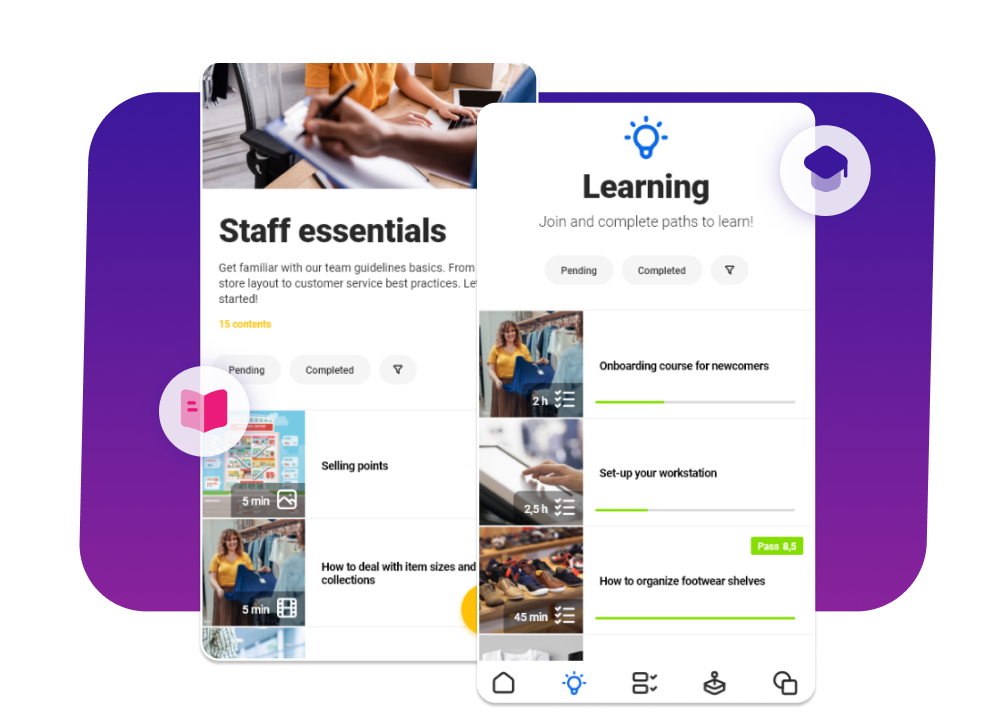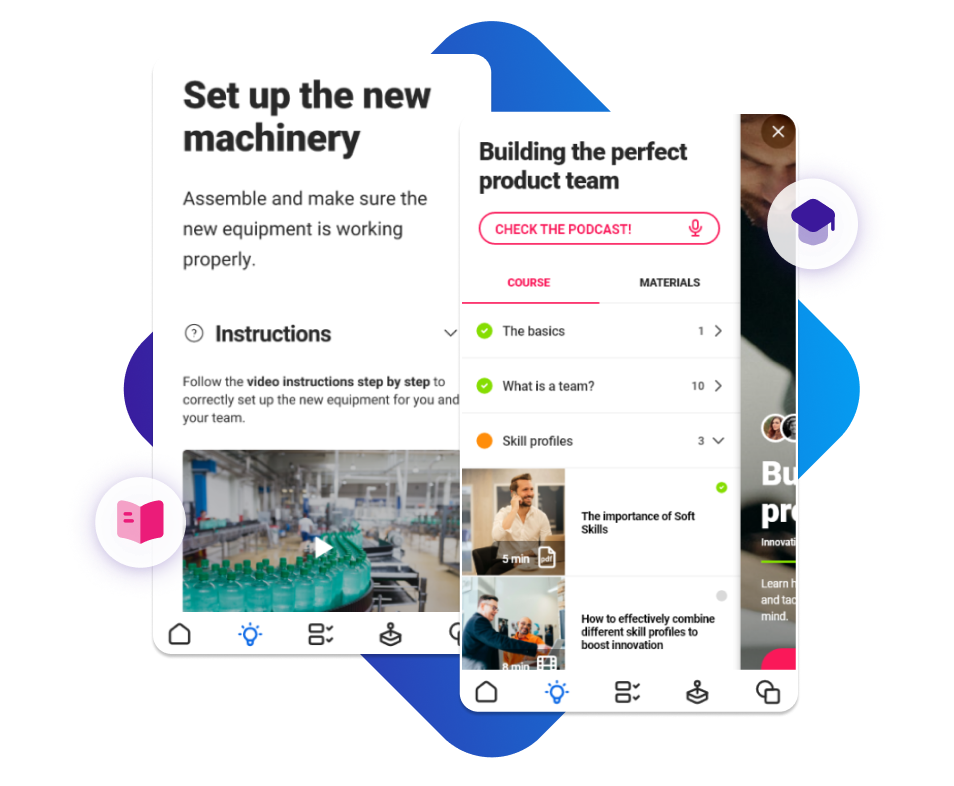Table of contents
ToggleA number of studies make a remarkable claim: the average employee is likely to answer more than 100 emails a day. However, this same employee will usually dedicate no more than 24 minutes a week to learning. Reduced attention spans, constantly changing work environments, and the demands of a more digitalized world have forced companies to rethink their approach to corporate training. And it’s against this backdrop that microlearning comes into focus.
What do you do when you want to cook a dish but you don’t know how? Or when you need to fix a broken device? You simply go to YouTube and look for a tutorial that answers your question, usually in under 15 minutes. In essence, microlearning is just that.
This learning approach is one of the key e-learning trends of recent years, and an effective addition when training a new workforce. But what exactly is microlearning, and what is it used for? Moreover, how can it be implemented correctly? In this post, we’ll discover the full significance of microlearning in corporate training.
What is microlearning and what characteristics does it have?
Microlearning is a learning methodology that breaks down information into small doses, or ‘knowledge pills’, that are easy to assimilate. It works by offering users learning modules with a duration of approximately 2 to 15 minutes, reducing the time needed for training, maintaining student interest, and improving knowledge retention.
A unique feature of this approach is that each microlearning module is designed with specific learning objectives in mind. This ensures that important concepts can be addressed directly and effectively.
Key characteristics of microlearning
To better understand what microlearning is, we need to have a good grasp of its main characteristics. These include the following:
- Adaptability: this learning style is ideal for any type of employee, with or without a desk, since it allows learning content to be accessed anytime, anywhere, from a variety of devices.
- Flexibility: as students can access learning materials anytime, anywhere, they can easily fit training into their schedule.
- Provides information concisely: it has been proven that the human brain better retains knowledge when it is delivered in short bursts. Through microlearning, employees can absorb and recall information more effectively, because it is presented in a more concise, focused way.
- Multi-format: microlearning allows employees to choose the learning format that best suits their preferences. Choices include videos, images, audios, exercises and more, each enhancing the educational experience if chosen effectively.
- High degree of customization: its customizable nature makes it an excellent learning approach for the modern workforce.
The advantages of using microlearning in corporate training
Microlearning has proven highly effective in business training programs, by allowing for the rapid learning and reinforcement of specific, valuable skills within the workplace. Among its main advantages, we can highlight the following:
1. Improves attention and knowledge retention
By providing shorter, more focused training modules, students’ attention span is respected and enhanced. Think about it – an employee is far more likely to successfully complete a 10-minute module than one which lasts 45 minutes to an hour. This fact translates into higher completion rates.
Additionally, when information is delivered in short and precise doses, it becomes much easier to remember in the short and long term.
2. Optimizes time spent learning
Microlearning allows students to make good use of downtime, such as pauses between meetings or even periods of travel. Since training is accessible through mobile devices, it integrates well into today’s fast-paced lifestyle, where employees can move around while remaining connected.
3. Demands less investment
Microlearning offers the opportunity for savings in training on two fronts: first, in terms of personnel, since fewer teachers are required; and second, in infrastructure and time. Furthermore, a company that invests in microlearning because it cares about the development of its employees, better aligns its professionals with the organization’s wider objectives, and so obtains better results.
4. Increases employee commitment
Remaining attentive to a long, tedious learning session can be a challenge for even the most committed worker. However, when an employee knows ahead of time that the learning process will take only a few minutes, it becomes much easier to focus their attention. Microlearning helps employees to handle more information in shorter periods of time.
5. Reduces cognitive overload
Microlearning, unlike traditional training, does not run the risk of overloading students’ memory. By offering short bursts of information, employees are given the space to process information better, avoiding fatigue and raising engagement levels.
How is microlearning used in companies? Practical examples of when to apply it
Although it is certainly a highly effective learning format, it’s important to know exactly when and in which cases to apply microlearning. The method works best when used to learn specific individual skills, and although it can help with more complex content, in these cases it works best as a complement, or as a smaller part of a wider course.
According to this report on the role of microlearning in corporate training, some of the situations in which microlearning can be an effective learning tool include:
Just-in-time learning
These are learning modules that cover a very specific topic or skill, and are consistently placed at students’ fingertips so that they can be used when most needed.
These just-in-time micro-courses line up with the way most people currently consume content on an everyday basis. For example, when a person needs to know something quickly, it’s commonplace for them to carry out a search on Google and locate the answer in the form of a short text, image or video. Taking advantage of this human inclination to look for instant answers is a highly effective way to train your employees.
Mobile learning
Mobile learning is currently one of the more practical solutions for the multitasking professional – the kind of employee who takes advantage of a subway ride or a relaxed lunch time to complete their training. In both cases, which do you think is the better option: an extensive 45-minute course, or a set of smaller 10-minute micro courses that can be consumed quickly? Without a doubt, microlearning can make a big difference in a situation like this.
Whenever-you-can learning
The “anytime” learning environment is fast becoming a working reality for many professionals as, according to Deloitte, many of them can only dedicate 1% of their work week to training.
For a professional working 40 hours a week, this translates into only 24 minutes per week, or 4.8 minutes per day, spent on training. When confronted with such a small amount of time, microlearning becomes increasingly attractive – and not only from the employee’s point of view, but also from the company’s, since this way employee training time is optimized.
Continuous learning
People tend to forget approximately 50 or 70% of what they have learned after the first 24 hours, until in some cases they forget it altogether. Continuous learning, when combined with microlearning, can help students to combat this forgetfulness.
Moreover, if training is provided in short courses with a variety of formats, such as games, challenges or questionnaires, it will simply become much easier for professionals to recall and put into practice this new knowledge.
Hard skills training
Microlearning is perfect for training employees in hard skills, since complex or very technical topics can be delivered by breaking them down into micro-courses. Such courses also benefit from the inclusion of videos or tutorials that make for a better, more thorough explanation.
How to design and integrate microlearning content for effective learning in your company
In order to successfully implement a microlearning strategy in your company, it’s essential to keep in mind the following recommendations:
Use interactive and attractive audiovisual elements
Visual content has a positive impact on information retention, which is why you should integrate graphics, videos and other interactive elements into your training modules. These resources better fit today’s quicker pace of life, and suit the modern student, making their training more attractive and easier to understand.
Offer relevant content
Always define the key concepts that you wish to transmit through microlearning, and ensure that your content lines up with these objectives, as well as focuses on the specific needs of both workers and organization.
Encourage collaboration and offer feedback
Incorporating collaborative and feedback elements into your learning modules helps to build a more dynamic learning environment. In this setting, employees can freely share experiences and knowledge, further enriching the learning process. Additionally, immediate feedback will help them to review their weaknesses and strengthen them in the future.
Include spacing and repetition techniques
Information given in small doses, when combined with spacing and repetition techniques, contributes to better long-term information retention. Therefore, when designing your modules you should aim to distribute content so that employees can easily return to specific topics after a certain interval of time.
Periodic assessments that address previously learned concepts are also highly useful tools to reinforce learning, as they encourage employees to recall key information on a regular basis.
Integrate gamification elements
Microlearning and gamification are both very effective methodologies which, when combined, strengthen motivation and promote further learning. Integrate elements such as daily challenges or quickfire questions into your microlearning modules to enhance the training experience and improve your results.
Carry out consistent monitoring and continuous evaluation
Implementing monitoring and evaluation systems allows you to measure the effectiveness of your training. Use data analytics to evaluate employee engagement and information retention, and assess how well it knowledge is being applied to the work environment. This way, you can adjust the content you include as necessary.
In which areas of training can microlearning be implemented?
Now that you know what microlearning is, and how to use it effectively, you may be wondering in which parts of your training program to properly apply it.
Microlearning can be effectively applied in onboarding programs, to provide explanations for specific tasks (such as with just-in-time learning) or even during internal communications, particularly when you’re aiming to align several company processes at once.
However, the main use of microlearning is undoubtedly in internal company training and, to this end, you can apply this methodology to countless areas of professional development. These include sales, productivity, digital skills, and more.
Furthermore, microlearning adapts itself perfectly to the newest generations of digital employees, remote workers, and even front-line professionals, giving them access to agile, dynamic training that they can always access through their smartphones.
What are the advantages of integrating microlearning and gamification?
Earlier, we mentioned that a good practice for implementing microlearning is to combine it with gamification. Why do it? Because gamification makes the microlearning experience even more engaging for learners, so they remember the acquired knowledge much better and for a longer time.
In conclusion, gamification and microlearning allow for:
- Encourage participation in training: employees in general see corporate training as something boring and imposed on them. This negative perception causes learning to become unattractive and with low participation levels. The union of gamification and microlearning allows learning to be fun and thus desired, thanks to each employee learning at their own pace, in a more relaxed environment.
- Motivation through play: when employees are motivated, learning is successful. The union of gaming and microlearning fosters participants’ curiosity, motivating them to achieve their educational goals. Strategies are used to help the game along, such as competing against the clock, giving points or using wild cards. These strategies encourage the desire for learning in the student through self-competition.
- Greater retention of high performance work teams: adapting to technological change is necessary to maintain a high-performance work team. The new generation likes challenges, keeping themselves qualified and in constant development.
- Variety of subjects: the combination of gamification and microlearning allows working with any subject, including the most tiresome and boring (risk prevention, regulations…).
With that being said, the integration of gamification and microlearning is the ideal combination to influence the productivity of workers and create a favorable learning environment, especially among the new generations of employees.
Examples of effective microlearning
As we’ve seen, microlearning easily adapts to a wide range of learning contexts and needs, from corporate training to online education. Let’s take a look at some typical examples of what microlearning content can look like:
- Short training videos
- Infographics and illustrations
- Questionnaires
- Interactive tutorials
- Interactive resources
- Simulations and learning scenarios
- Online mini-courses
- Gamification activities
- Checklists
- Podcasts
Discover isEazy Engage, the training app for frontline workers
Microlearning can help a company to dramatically reduce both the time and costs it needs to invest in training its employees. At the same time, it allows employees to acquire new knowledge quickly and easily, which helps them to develop their professional careers without requiring extra effort or investment.
So, if you want to start enjoying all the advantages that microlearning has to offer, then discover isEazy Engage – the perfect microlearning app to get your employees hooked on training from the very first moment. Design your training with the most attractive – and addictive – interactive micro-content available, and multiply your results while your employees learn effortlessly.
















